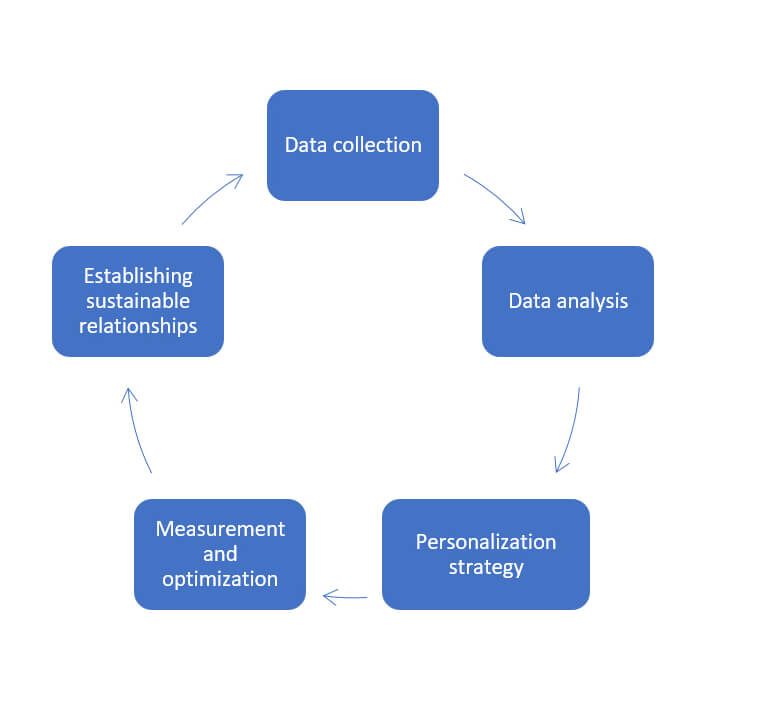
Strengthening Customer Relationships Through Personalized Customer Experience in the B2B Sector
Definition and Characteristics of Personalized Customer Experience
A personalized customer experience aims to provide each customer with a tailored experience that considers their specific needs and preferences. This approach surpasses conventional marketing strategies by recognizing each customer individually with specific desires and expectations. Personalization can be achieved in different ways:
Communication: Through customized communication methods, such as individually designed emails or advertisements, a company can interact directly and personally with business partners. This communication is based on the history of interaction and the preferences of the business customer with the company. For example, a pharmaceutical company could use personalized emails to specifically inform pharmacies about new diabetes medications, based on their previous orders and needs.
Offers: For example, automotive suppliers can develop personalized offers based on the past interactions and purchasing behavior of a business customer, such as a car manufacturer. Examples of this would be tailor-made components or exclusive access to new technologies.
Recommendations: The use of specific recommendation systems enables companies to propose products, technologies or services that are precisely tailored to the needs and objectives of business customers. A practical example of this is a manufacturer of industrial plants, which uses such a system to recommend special maintenance plans to its customers, which are individually adapted based on their usage patterns and product life cycles.
Why are specific customer experiences important?
Meeting customer expectations: A personalized customer experience is crucial in meeting the expectations and needs of customers. In today's economy, where products and services are becoming increasingly interchangeable, a company's ability to provide unique and customized experiences is a key factor in standing out from the competition. Customers expect not only high-quality products or efficient services, but also that companies understand and respond to their individual preferences and needs.
Generating new sales and preventing losses: Studies show that B2B customers are willing to pay more for very good customer experiences, with 86% of B2B buyers willing to accept a price premium for a very good experience. This emphasizes the importance of effective personalization in customer service to boost sales and minimize purchase drop-out rates.
Creating supportive business customer communities: Studies show that the often-missing direct connection to end users makes customer relationships in the B2B sector challenging. A good understanding of the needs and expectations of both buyers and end users is therefore crucial for the development of business relationships.
Approach to a Personalized Marketing Strategy

Step 1: Create a data basis
In the first step, data should be collected to develop an initial understanding of the B2B customers. Market research institutes can collect valuable primary data through secondary research, surveys, or interviews. Special attention is paid to the following aspects:
- Demographic data such as names and locations of companies.
- Company-related data such as industry and annual turnover.
- Behavioral data on interactions on the website or app.
- Context data such as device and browser types.n
Step 2: Analyze data
The collected data are then examined using analysis methods such as customer segmentation. These and other market research methods allow precise grouping of customers based on common features such as industry, company size, or location.
Step 3: Implementation of the personalization strategy
Now, based on the analyzed data, personalized marketing strategies are implemented that are tailored to the specific needs and expectations of the B2B customers. For example, emails with industry news relevant to each business customer could be sent, or specific webinars on topics that are currently relevant in the customer's industry could be offered. Market research can provide insights into the effectiveness of different communication channels and messages.
Step 4: Measurement and optimization
The success of personalized marketing activities is regularly evaluated in this step. Market research tools like Google Analytics are used to track metrics such as conversion rates and return on investment (ROI). The strategies are adjusted accordingly to maximize the effectiveness of the measures.
Step 5: Building sustainable B2B relationships
Finally, market research supports the establishment and maintenance of long-term customer relationships. This can be achieved through regular feedback loops, individually tailored customer service offers, and consideration of customer feedback in product development.
Further Information
If you would like to learn more about how a personalized customer experience can strengthen your company's customer relationships in the B2B sector, we are at your disposal. We would be happy to discuss which research approaches and strategies can specifically promote the development process of your products or services.
Text written by Paul Alexander Abel